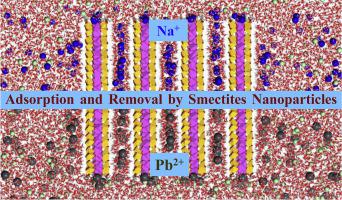Applied Clay Science ( IF 5.3 ) Pub Date : 2021-01-02 , DOI: 10.1016/j.clay.2020.105957 Xiantang Liu , Sen Yang , Peike Gu , Sai Liu , Gang Yang

|
Clay minerals are efficient adsorbents for metal ions and have been widely used to control heavy metals, while a number of critical issues remain elusive. In this study, the fully flexible models for smectites (montmorillonite and beidellite) nanoparticles are developed and then subject to molecular dynamics simulations. Edge rather than basal and interlayer surfaces show much higher adsorption efficacy, and therein univalent metal ions always cause excessive adsorption. For montmorillonite, inner-sphere Pb2+ ions emerge and predominate only at edge surfaces, and have higher stability than inner-sphere Na+ ions, manifesting the central role of edge surfaces to remove heavy metals. The peculiar distribution of edge-O atoms causes similar coordination environments for inner- and outer-sphere metal ions, and inner-sphere metal ions are preferred significantly due to bonding with edge-hydroxyls. Metal ions with smaller radii are more favorable to adsorb at edge surfaces, and those with considerable hydration effects (e.g., heavy metals) can be preferred. Edge surfaces of montmorillonite rather than beidellite are more efficient for adsorption, mainly as a result of distinct adsorption behaviors at basal surfaces that show reversed trends. (010) rather than (110) edges are superior for adsorption, which is caused mainly by structural differences. (010) edges are more exposed to adsorbates, and cleavage of smectites nanoparticles along (010) edges enhances removal of heavy metals. Diffusion, mobility and stability of adsorbed metal ions are also discussed, which further understanding of adsorption at edge surfaces. The findings are consistent with experimental observations available and provide new insights to the complicated processes at clay minerals/water interfaces including control of heavy metals.
中文翻译:

蒙脱石纳米颗粒对金属离子的吸附和去除:机理,电荷位置和边缘结构的影响
粘土矿物是金属离子的有效吸附剂,已被广泛用于控制重金属,但许多关键问题仍然难以捉摸。在这项研究中,开发了蒙脱石(蒙脱石和贝得石)纳米粒子的完全柔性模型,然后对其进行分子动力学模拟。边缘而不是基底和夹层表面显示出更高的吸附功效,并且其中一价金属离子始终会导致过度吸附。对于蒙脱土,内球Pb 2+离子仅在边缘表面出现并占优势,并且比内球Na +具有更高的稳定性。离子,显示出边缘表面去除重金属的中心作用。边缘O原子的特殊分布导致内球和外球金属离子具有相似的配位环境,并且由于与边缘羟基键合,内球金属离子明显更可取。具有较小半径的金属离子更易于吸附在边缘表面,具有水合效果的金属离子(例如重金属)可能是首选。蒙脱土而不是贝得石的边缘表面吸附效率更高,这主要是由于基底表面的独特吸附行为呈现出相反的趋势。(010)而不是(110)边缘在吸附方面更具优势,这主要是由于结构差异引起的。(010)边缘更容易被吸附物暴露,沿(010)边缘的蒙脱石纳米粒子的裂解增强了重金属的去除。还讨论了被吸附金属离子的扩散,迁移率和稳定性,从而进一步了解了边缘表面的吸附。这些发现与现有的实验观察结果一致,并为粘土矿物/水界面的复杂过程(包括控制重金属)提供了新的见解。











































 京公网安备 11010802027423号
京公网安备 11010802027423号